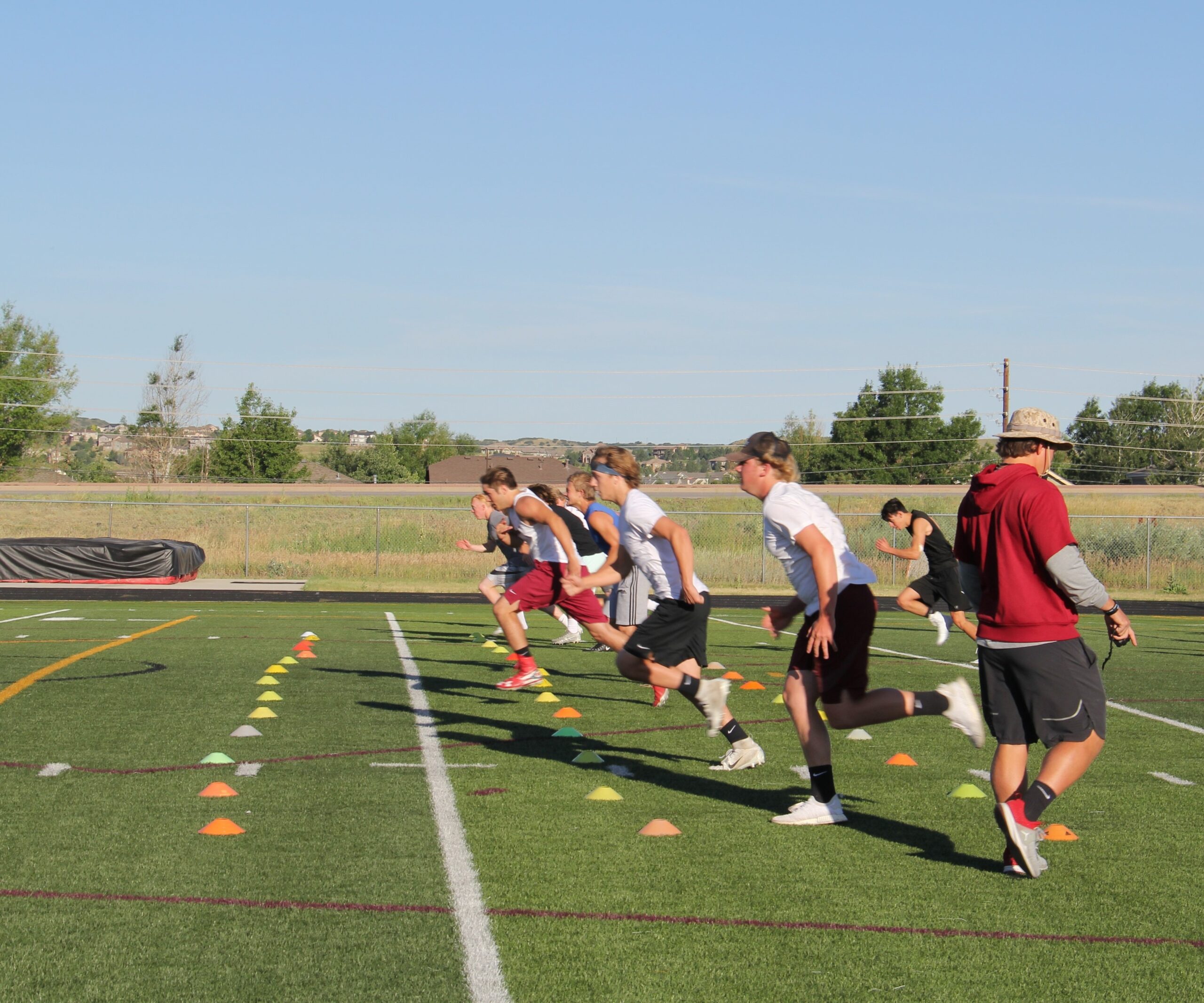Periodization in the Private Setting is Alive and Well!
UncategorizedABOUT THE AUTHOR

Tim Caron
At the gym, he’s known affectionately as T-BONE. This industry-leading strength coach has two Master’s degrees—one in Performance Enhancement and Injury Prevention and one in Strength and Conditioning. Before Allegiate, T-BONE was the Head Football Strength and Conditioning Coach at Army West Point. He helped Army beat Navy for the first time in 15 years—an explosive triumph in one of the oldest football rivalries in sports. Before Army, Tim was an Associate Strength Coach at USC, where the Trojans came off a 10-2 season and ranked number 1 in the country. He worked with the football team on nutrition, injury and rehabilitation protocol, preparing players for the NFL Combine. From the warm up and workout to the recovery, you’ll get plenty of T-BONE time (he takes pride in directly coaching every member), and the dynamic program he has personally designed is guaranteed to take you to the next level.
// Is periodization dead?
I hear this from time to time, is not a new debate, from my perspective it is the cornerstone of programming in any setting which I guess that means (in my opinion) it is most definitely alive and well.
If you are planning frequency, intensity, volume, density, exercise selection/progression you are periodizing your program. Periodization is just planning, that is it; if you are competent and are actually applying some sort of strategy to your setting you are most certainly periodizing your program.
The negative aspect of saying periodization is dead is that it pulls us from creating systems and applying principles. Principles by definition are universally true: if we just abandon principles we are leading our training outcomes more and more out of control. Systems and integration of principles are all about having more uniform or consistent output, which from the perspective of training is a really good thing.

For instance progressive overload is one that should be used in all situations. We can progress in three major ways: volume (increasing sets or reps/time under tension), intensity, or density (more work in the same time or the same work in less time). Can we actually make a progression in some way determines the quality of our predictions and guidance during training. Are we including all factors such as overall training stimulus, quality of execution, inclusion of outside stressors, understanding of longer term strategies is the determinant of your training plan and needs to be accounted for.
So how do we account for that? The classic line is “Plan your Work, Work your Plan”, which one is not more important than the other. We need to address this as we would any problem set: what is the problem (or what do want to accomplish), formulate an intervention, implement, and test if the intervention (premise or execution) was correct.
Private Setting Periodization
Key Terms:
Your Title Goes Here
Your content goes here. Edit or remove this text inline or in the module Content settings. You can also style every aspect of this content in the module Design settings and even apply custom CSS to this text in the module Advanced settings.
Undulating Periodization
Alternating sequence of volume/intensity
Block Periodization
Concentrated periods of more singular focus in sequenced in specific way to garner positive outcomes
Accumulation
Higher Volumes/Lower Intensities
Intensification
Lower Volumes/Higher Intensities
Workload
Rate of Perceived Exertion (1-10 Scale) multiplied by minutes of activity
Acute Score
Weekly Sum of Average Workload
Chronic Score
Block (or Longer) Average of Acute Score
Acute:Chronic
Ratio of Acute to Chronic to track relative stimulus
The most important factor to consider in periodization is the balance of volume and intensity. In a team setting you have more autonomy of frequency so this is easily manipulated, in a private setting you have lesser control of frequency so you shift your strategy towards recommending frequency adjustments which by default lowers overall training volume.
“Hey you look tired, you should take a day off”
The other factor in private verse team settings is the presence of a timeline. There is off season and in season, regular season verse postseason, or there is designated periods of mandatory versus non mandatory. There is no such thing in the private setting, it is more or less groundhogs day, they just keep coming. Knowing the net outcome is largely tied into either or all the above looking better (adding muscle or improving body composition), performing better (increasing force and/or velocity), or feeling better (increased mobility or fitness) whcih we can address with more of a global response.
This leads us to non linear periodization schemes that we can utilize a more utilitarian approach. We have no definitive timeline nor do we have any clear objectives, so we need to organize our volume and intensity in a manner that keeps us moving net positive at all times. Similar to work with team sports where we need to cover a lot of bases and we shift to a more nonlinear model to develop multiple qualities at once. In our setting we utilize a strategy of Undulating/Block periodization to maximize a quality over a selected period of time and funnelling everyone generally into an outcome that was listed before.
Your Title Goes Here
Your content goes here. Edit or remove this text inline or in the module Content settings. You can also style every aspect of this content in the module Design settings and even apply custom CSS to this text in the module Advanced settings.
Accumulation
Endurance (Oxidative Capacity)/Hypertrophy (Glycolytic Capacity)
Intensification
Functional Hypertrophy (Glycolytic Power)/Relative Strength (Phosphagen Capacity/Power)
The other big concept to work through is standard distributions. People fall into the majority (60-80%) and high (10-20%) and low (10-20%) low responders. Our focus is the majority, which guides our loading and block orientation set up. Typically people respond to a traditional loading style of increasing Relative Intensity over the course of four weeks (Week 1 70%, Week 2 80%, Week 3 90%, and Week 4 100%), combined with most people are Intermediate trainees which need four weeks of prescribed set/rep/exercise prescription to truly adapt to the stimulus.
So the problem therefore is the desired outcome (Look Better, Perform Better, Feel Better) our intervention is Block/Undulating Periodization (Four Week Traditional Loading Periods, alternating focus of Accumulation and Intensification Blocks). The last thing to do is assess the intervention.
Conformational bias is a term that holds great weight in the scientific community. It is the assertion that something is true regardless of testing or attempting to prove it. This is commonplace in our industry, we actually associate our identity with these biases more so than any other profession. I powerlift so everyone has to squat, bench and deadlift to reach an outcome, or I olympic lift so the only two exercises to do are snatch and clean & jerk. We overly associate the effectiveness and are resistant to other perspectives and possible vantage points because it challenges our identity more so than effectiveness or efficacy.

To truly assess if our intervention as a good intervention, we need to be as non partisan as possible. We focus on a couple of metrics Impulse, Relative Strength, and Workloads. The other big part is if there is a level of overall objectivity, participant subjectivity, reliability and validity. Validity is where conformational bias has the most influence over, taking general assessments and not cherry picking tests that validate results. Reliability is about removing the human error element as much as possible, since we have lesser control of frequency and mandating specific constraints picking higher interrater reliability tests than anything. Objectivity and subjectivity are tied into the idea of we need to know if we are improving from both a coach and participants perspective.
So we track force output and force output (Impulse) in a specific time interval (Impulse per 100miliseconds) on a force plate; which takes the human component out of it and can see overall objective measurement from our training. We use Rate of Perceived Exertion for subjective perspective, which we use that calculate workloads to create Acute:Chronic scores to see if we are addressing globally if we are applying the correct stimulus. Finally we use Functional Movement Screen (high interrater reliability movement assessment) and relative strength tests of bodyweight pull up or hold and body weight bench/pushup for maximal repetitions.
We track this in a combination, of daily, weekly, monthly, quarterly and annually assessments. The part that ties back into periodization is the understanding of the impact on frequency on these results. We can control overall volume and subsequently outcomes in these areas based on how much we can impact the system. As the physiological adaptations increase we add more, if they demonstrate they are not adapting we subtract. The bottom line it has to be a net positive towards the specific outcomes, if not we are not servicing people we are confirming our own beliefs.
Closing Remarks
I get why it is easy to say periodization is not applicable or there are holes in the logic. That is simply too easy and a cop out. People are dumping billions into training in this country and our net result is the highest rates of cardiovascular disease and metabolic disease in the history of humans. Yeah this is multivariate and extremely complex subject, but one of the biggest controls is actually physical activity but we are missing the mark on the level of impact physical activity could be having based off poor application of principles and longer planning.
It is not easy to get new customers, and they have autonomy on when and where they go. Which makes doing “best practice” difficult in the face of doing what sells; if they want something they will go to someone that will give it to them. The understanding of physical laws and principles not just in training but biology should never be ignored, but it is and we not moving the needle to helping people to better health and function. Short term concessions versus long term (lifelong) results should be everyone’s focal point, it can be if we attempt to understand more about biology and physiology there is no other way.
Plan your Work, Work your Plan
Are you a better coach after reading this?
More coaches and athletes than ever are reading the TrainHeroic blog, and it’s our mission to support them with useful training & coaching content. If you found this article useful, please take a moment to share it on social media, engage with the author, and link to this article on your own blog or any forums you post on.
Be Your Best,
TrainHeroic Content Team
HEROIC SOCIAL
HEROIC SOCIAL
TRAINING LAB
Access the latest articles, reviews, and case studies from the top strength and conditioning minds in the TH Training Lab

